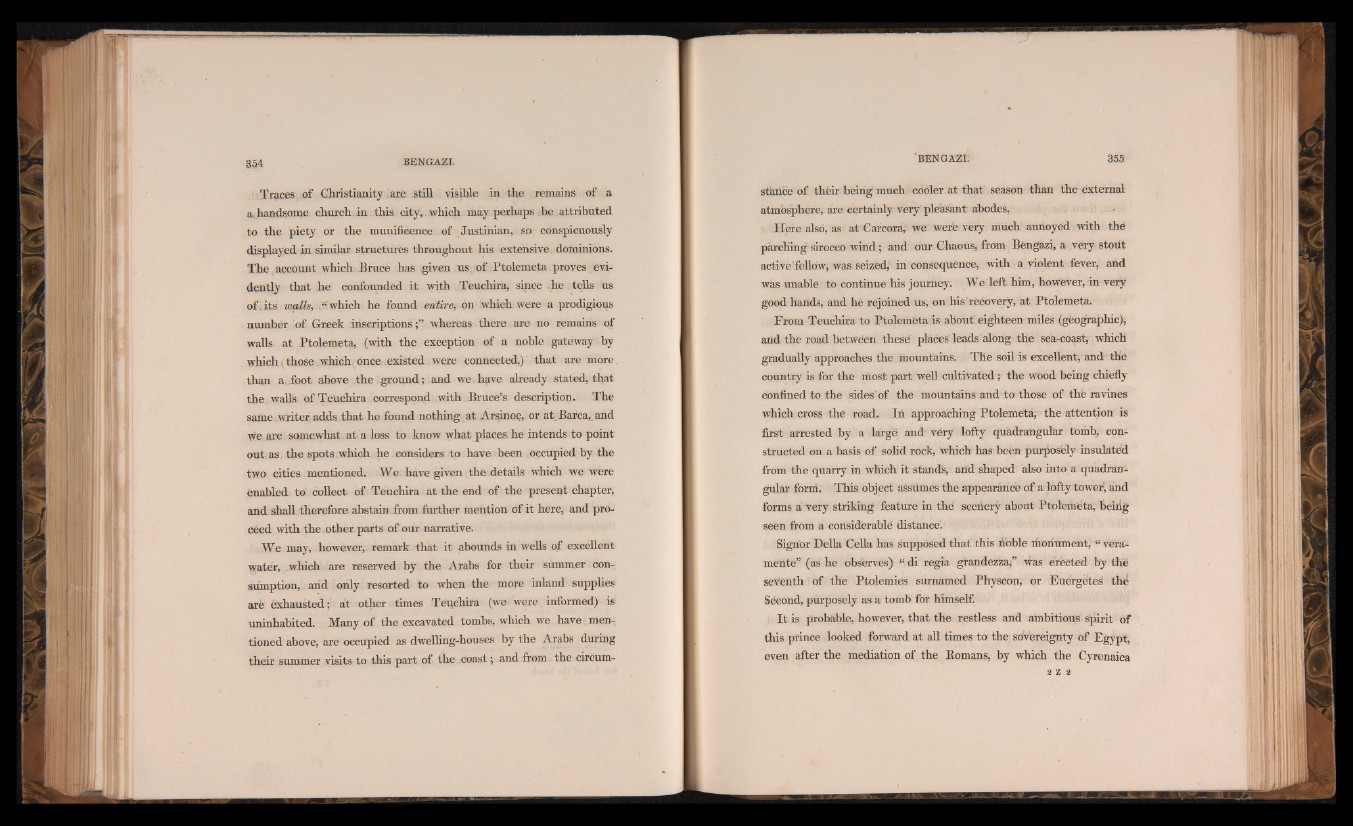
Traces of Christianity .are still visible in the remains of .a
a handsome church in this city,, which may perhaps be attributed
to the piety or the munificence of Justinian, so conspicuously
displayed in similar structures throughout his extensive dominions.
The,account which Bruce has given us of Ptolemeta proves,evidently
that he confounded it with Teuchira, since ,he tells us
of,its malls, “which he found entire,, on which were a prodigious
number of Greek inscriptionswhereas there are no remains of
walls at Ptolemeta, (with the exception of a noble gateway by
which, those .which once existed were connected,) that are more,
than a.foot above ¡the ground; and we.have already stated, that
the. wall's of Teuchira correspond with Bruce’s description. The
same writer adds that he found nothing at Arsinoe, or at. Barca,, and
we are. somewhat.at a loss to know what places he intends to point
out.as, the spots which he considers to have been occupied by the
two cities mentioned. We have given the details which we were
enabled to collect of Teuchira at the end of the present chapter,
and shall therefore abstain from further mention of it here, and proceed
with the other parts of our narrative.
We may, however, remark that it abounds in wells of excellent
water, .which are reserved by the Arabs for their summer consumption,
and only resorted to when the more inland supplies
aré exhausted; at other times Teuchira (we were informed) is
uninhabited. Many of the excavated tombs, which we have mentioned
above, are occupied as dwelling-houses, by the Arabs during
their summer visits to this part of the coast; and from the circumstance
of their being much copier at that' season than the external
atmbsphere, are certainly very pleasant abodes, _ I
Here also, as at Carcora, we werfe very much annoyed with thé
parching sirocco wind ; and our Ghaous, from Bfengazi, a very stout
active fellow, was seized,' in consequence, with a violent-fever, and
was unable to continue his journey. We left him, however, in verÿ
good hands, and hé réjoined us, on his'recovery, at Ptolemeta.
From Teuchira to Ptolemèta is about eighteen miles (géographie),
and the road betwëen these' places'leads' along the sea-coast, which
gradually approaches the mountains. The soil is excellent;-and the
country is for the most part well cultivated ; the wood being chiefly
confined to the sides'of the mountains and to those of thè ravines
which cross the road. In approaching Ptolemeta; the attention is
first arrested by a largë and véry lofty quadrangulär tomb, constructed
on a basis of solid rock, which has-beén purposely insulated
from the quarry in which it stands, arid shaped also into a quadrangular
form. This object assumes the appearance of a lofty tower) and
forms a very striking feature in the sceriery about Ptolemeta; being
seèn from a corisiderablé distance!
Signor Della Celia has supposed that this ribble ifioriument, “ veramente”
(as he observés) “ di regia grandezza,” was erected by the
seventh of the Ptolemiés surnamed Physcon,- or Euergetes thé
Second, purposely as a tomb for himself.
I t is probable, however, that the restless and ambitious spirit of
this prince looked forward at all times to the sovereignty òf Egypt,
even after the mediation of the Romans, by which the Cyrenaica